Summary | Excerpt | Reviews | Beyond the Book | Read-Alikes | Genres & Themes | Author Bio
A 19th Century Bookseller's Obsession with a Lost Masterpiece
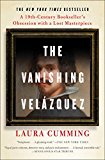
Critics' Opinion:
Readers' Opinion:
First Published:
Apr 2016, 304 pages
Paperback:
Nov 2016, 320 pages
 Book Reviewed by:
Book Reviewed by:
Kim Kovacs
Buy This Book
This article relates to The Vanishing Velazquez
Diego Velázquez (1599 - 1660) was a painter in the court of Spain's Philip IV during the Spanish Golden Age (Siglo de Oro), a period influenced by the Italian Renaissance, during which the arts flourished throughout the country. The exact dates of the Spanish Golden Age vary by commentator, but it began no earlier than 1492 with Columbus's discovery of the New World, and ended no later than 1681 with the death of author Pedro Calderon de la Barca. The movement encompassed literature, including poetry, plays and novels, music, sculpture, painting and architecture.
Some of Velázquez's contemporaries who were active during the time are:
El Greco (1541 – 1614)
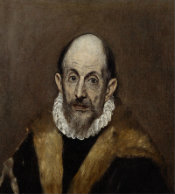 El Greco means "The Greek" in Spanish, reflecting his origins in Greece. Born Domenikos Theotokopoulos in Crete, he traveled to Spain and worked as an icon painter. By 1577 he had moved to Toledo, the seat of the Catholic Archbishop as well as the center of the Counter-Revolution, which explicitly endorsed religious art. He began painting religious subjects on commission. Known for his elongated figures, unusual color combinations, and figures intertwined in complex poses, for the most part, his art was not well-received during his lifetime. These days however it's regarded as a precursor to both Expressionism and Cubism, although scholars say that El Greco's art is so unique that it can't be classified in any conventional school of artistic thought. El Greco's paintings of Toledo became models for a new European tradition in landscapes.
El Greco means "The Greek" in Spanish, reflecting his origins in Greece. Born Domenikos Theotokopoulos in Crete, he traveled to Spain and worked as an icon painter. By 1577 he had moved to Toledo, the seat of the Catholic Archbishop as well as the center of the Counter-Revolution, which explicitly endorsed religious art. He began painting religious subjects on commission. Known for his elongated figures, unusual color combinations, and figures intertwined in complex poses, for the most part, his art was not well-received during his lifetime. These days however it's regarded as a precursor to both Expressionism and Cubism, although scholars say that El Greco's art is so unique that it can't be classified in any conventional school of artistic thought. El Greco's paintings of Toledo became models for a new European tradition in landscapes.
Jusepe de Ribera (1591 – 1652)
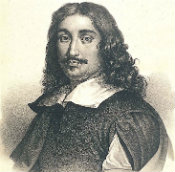 At the age of 25, Ribera settled in Naples, which was under the Spanish Crown at the time. He is best known for his "dark, twisted, often gory and sometimes downright bizarre paintings of torture, martyrdom and freaks." His early work is heavily influenced by Caravaggio, demonstrating extensive use of chiaroscuro (strong contrast between light and dark) and tenebrism (heavy shadow), while his later paintings have a lighter style and brighter colors, reflecting the influence of Rubens and Van Dyck. Working on the eastern edge of the country, Ribera helped introduce new techniques developed in Italian art to Spanish painters, and had a strong influence on other Spanish artists of the day.
At the age of 25, Ribera settled in Naples, which was under the Spanish Crown at the time. He is best known for his "dark, twisted, often gory and sometimes downright bizarre paintings of torture, martyrdom and freaks." His early work is heavily influenced by Caravaggio, demonstrating extensive use of chiaroscuro (strong contrast between light and dark) and tenebrism (heavy shadow), while his later paintings have a lighter style and brighter colors, reflecting the influence of Rubens and Van Dyck. Working on the eastern edge of the country, Ribera helped introduce new techniques developed in Italian art to Spanish painters, and had a strong influence on other Spanish artists of the day.
Juan van der Hamen (1596 – 1631)
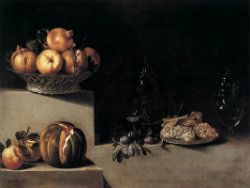 The son of a Flemish aristocrat living in Madrid, Van der Hamen is widely regarded as one of the greatest still-life painters of the 17th century. During his lifetime he was well-known for his versatility, painting landscapes, allegories, flowers, and large-scale works for convents and churches. According to the National Gallery of Art, "Van der Hamen's virtuoso ability to mimic nature is evident in his treatment of the small, water-filled glass bowl, which not only casts a shadow but also refracts the light passing through it. The poet Lope da Vega, who was a member of the same educated circle as the painter, wrote two sonnets in praise of van der Hamen's work, suggesting in one that nature herself should copy his fruits and flowers." He simplified his still lifes by reducing the number of items depicted, while at the same time complicating them by putting the items on different levels and using dramatic lighting.
The son of a Flemish aristocrat living in Madrid, Van der Hamen is widely regarded as one of the greatest still-life painters of the 17th century. During his lifetime he was well-known for his versatility, painting landscapes, allegories, flowers, and large-scale works for convents and churches. According to the National Gallery of Art, "Van der Hamen's virtuoso ability to mimic nature is evident in his treatment of the small, water-filled glass bowl, which not only casts a shadow but also refracts the light passing through it. The poet Lope da Vega, who was a member of the same educated circle as the painter, wrote two sonnets in praise of van der Hamen's work, suggesting in one that nature herself should copy his fruits and flowers." He simplified his still lifes by reducing the number of items depicted, while at the same time complicating them by putting the items on different levels and using dramatic lighting.
Francisco de Zurbaran (1598 – 1664)
De Zurbaran began sketching in charcoal as a small child. Recognizing his talent, his father was able to get him an apprenticeship with a well-known painter in Seville – Pedro Diaz de Villanueva – in 1614. The appointment allowed him to meet many influential Spanish painters of the day. Nicknamed the Spanish Caravaggio, his works employ chiaroscuro and have been described as severe, austere and ascetic. Most of his paintings were commissioned for religious institutions and reflect a religious theme. In addition to dramatic shading, his works display a naturalistic style. De Zurbaran was particularly proficient in painting on fabrics and was well known for creating works of art on draperies.
Bartolome Esteban Murillo (1618 – 1682)
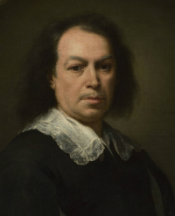 Murillo succeeded Zurbaran in Seville, obtaining contracts for religious paintings from institutions in the city. He is best known for his religious works, but he also painted contemporary women and children, including realistic portraits of flower girls, street urchins and prostitutes. He's one of the few artists of the day who painted scenes from real life. Initially heavily influenced by Zurbaran and employing strong chiaroscuro, his style became lighter and softer over time, often with a sentimental sweetness. He was particularly admired for his ability to capture often fleeting facial expressions.
Murillo succeeded Zurbaran in Seville, obtaining contracts for religious paintings from institutions in the city. He is best known for his religious works, but he also painted contemporary women and children, including realistic portraits of flower girls, street urchins and prostitutes. He's one of the few artists of the day who painted scenes from real life. Initially heavily influenced by Zurbaran and employing strong chiaroscuro, his style became lighter and softer over time, often with a sentimental sweetness. He was particularly admired for his ability to capture often fleeting facial expressions.
Picture of El Greco's Portrait Of A Man from Metmuseum.org
Picture of Jusepe de Ribera from Biblioteca Nacional de España
Picture of Bartolomé Esteban Murillo from Biblioteca Nacional de España
Still life of fruits and glassware from Museum of Fine Arts, Houston
Filed under Music and the Arts
![]() This "beyond the book article" relates to The Vanishing Velazquez. It originally ran in April 2016 and has been updated for the
November 2016 paperback edition.
Go to magazine.
This "beyond the book article" relates to The Vanishing Velazquez. It originally ran in April 2016 and has been updated for the
November 2016 paperback edition.
Go to magazine.





The House on Biscayne Bay
by Chanel Cleeton
As death stalks a gothic mansion in Miami, the lives of two women intertwine as the past and present collide.

The Flower Sisters
by Michelle Collins Anderson
From the new Fannie Flagg of the Ozarks, a richly-woven story of family, forgiveness, and reinvention.

The Funeral Cryer by Wenyan Lu
Debut novelist Wenyan Lu brings us this witty yet profound story about one woman's midlife reawakening in contemporary rural China.
Your guide toexceptional books
BookBrowse seeks out and recommends the best in contemporary fiction and nonfiction—books that not only engage and entertain but also deepen our understanding of ourselves and the world around us.